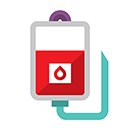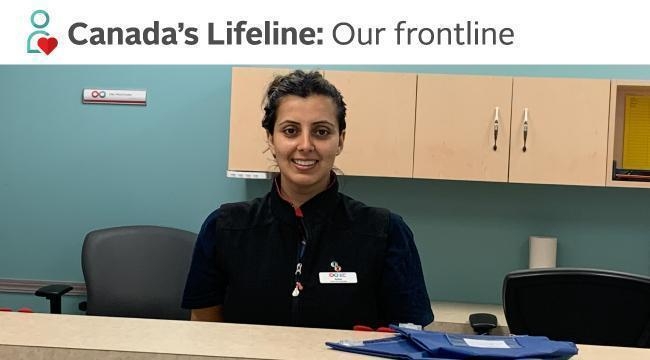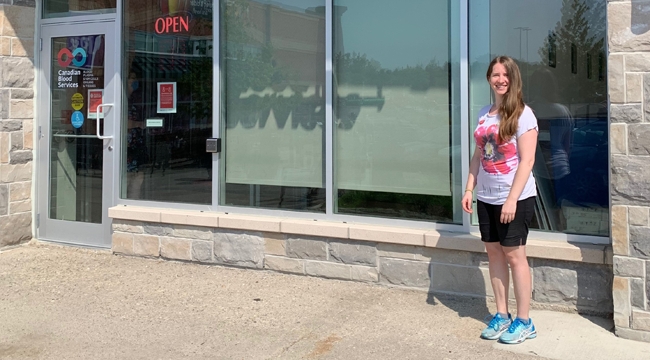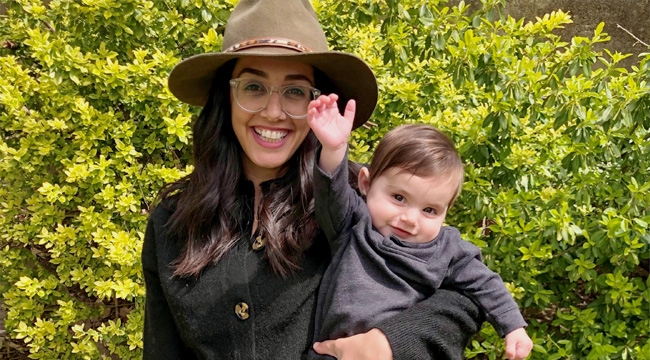From blood donor, to recipient, to team Canada
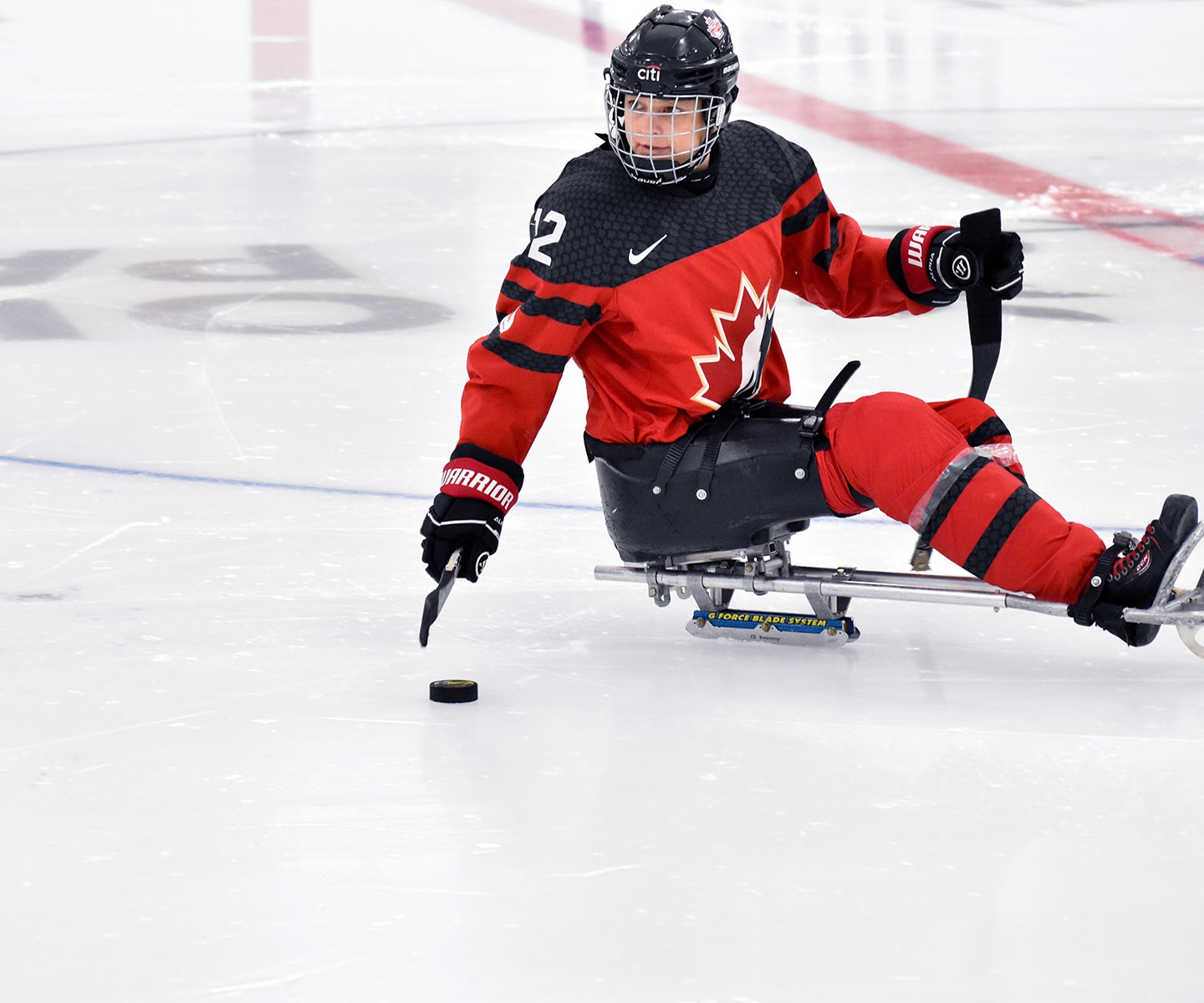
Alicia Souveny found her way to the national women’s para-hockey team after losing her leg in a winter freeway crash
Just a few years after a terrifying freeway crash left Alicia Souveny with life-altering injuries, she’s excelling in sport with a national team — and grateful to the blood donors who helped make it possible.
Alicia was heading to work on an icy Saturday in February 2019 when her car slid into the median of a freeway in Edmonton, Alta. She’d exited the car and was speaking with a motorist who’d stopped when another vehicle slammed into her.
Her injuries were extensive. She suffered damage to her spleen and gall bladder, multiple bone fractures and a traumatic brain injury, among others. But the biggest threat to her life in those first moments was likely the loss of blood.
“I had a lot of internal bleeding, and of course with my leg being crushed, there was a lot of blood coming from my leg,” says Alicia, a physiotherapist at a children’s hospital in Edmonton, Alta.
“Without blood, no matter what the doctors would have done, I wouldn’t have made it. Blood donors quite literally saved my life.”

O-negative blood donors make all the difference
Police were first called to the scene at around 8:15 a.m., according to news reports from that day. Less than an hour later, Alicia was already receiving her first transfusion of O-negative blood. O-negative blood is critical in situations where the patient needs blood so urgently there is no time to check their blood type first.
“In trauma they talk about the ‘golden hour,’” says Dr. Gwen Clarke, a transfusion medicine specialist with Canadian Blood Services. “You want to start the resuscitation and transfusion within the first hour of injury to avoid severe complications.”
Alicia’s records suggest she received 11 units of O-negative blood before her own blood type was confirmed. Since she was later discovered to be O-negative herself, she also received more O-negative blood in the days and weeks that followed.
Alicia also received other blood products during her long hospital stay: plasma, the straw-coloured blood component that makes up most of a person’s blood volume; platelets, the component that helps with clotting; and fibrinogen and albumin, two plasma protein products manufactured from blood plasma.
In fact, it would be difficult to pinpoint just how many different donors helped Alicia through her trauma. While each unit of O-negative red blood cells came from a single person, a transfusion of “pooled platelets” a few days after the crash came from multiple O-negative donors. And plasma protein products are made by pooling thousands of units of blood plasma at a time, from donors with a mix of blood types.
Before the crash, in part because of her role in health care, Alicia knew the importance of blood donors. She’d even pushed past a fear of needles to donate blood several times herself. But receiving it gave her a whole new perspective.
“If you’ve previously given blood, I can’t thank you enough for what you’ve done,” she says.

From blood recipient to team Canada
After three months in hospital — including a full month in intensive care — Alicia faced even more challenges, both physical and emotional. Her left leg had been amputated below the knee, so while dealing with exhaustion and pain, she was also learning to navigate the world in new ways.
And while she was grateful to be home, its familiar comforts were also painful reminders of the old life she was missing.
“You don’t really appreciate how lucky you are to be able-bodied until you’re no longer able-bodied,” she says.
Yet less than four years later, after a lot of hard work and the support of family and friends, Alicia is more active than she’s ever been. She’s been able to enjoy curling, swimming, cycling, skiing and more. But the sport she’s pursuing most seriously is para-hockey, a version of the game where players propel themselves across the ice on sleds.

While both Alicia and her fiancé, Matt, who is also a physiotherapist, had volunteered as trainers for minor hockey teams, she’d spent little time on the ice before she first tried para-hockey in 2021.
“I’d never handled a puck. I couldn’t stickhandle to save my life,” she confesses. But that’s part of the beauty of any para-sport, she notes. “In your 30s you can give it a try, with no funny looks.”
It didn’t take her long to shoot to the top, either. Later that same year, she was invited to train with the national women’s para-hockey team at a development camp, and after tryouts the following spring, she made the team herself.

Alicia is now also a player ambassador for Hockey Gives Blood — the first such ambassador from the para-hockey community. In a way she has come full circle. Edmonton’s hockey community supported her through fundraising from her earliest days in hospital, and organized blood donation events in her honour. Now, as a player ambassador, she inspires blood donors to help others.
Alicia has found other ways to support Canada’s Lifeline, too, including with a campaign called Step Up With Alicia. It’s encouraged financial gifts as well as blood donations. Financial donors fuel research, donor recruitment efforts and more.

Chances are, someone you know will need blood
You never know when you or someone you love will need donated blood. Alicia herself is a third-generation blood recipient. Her paternal grandfather received blood even before her dad was born, after he was kicked by a horse as a teenager.
“If my grandpa hadn’t had that blood, then my dad wouldn’t have existed,” Alicia says. “I wouldn’t have existed.”
And her father is a blood recipient as well. A few years before Alicia was injured, he required blood transfusions after a motorcycle crash.
In other words, donors didn’t just make a difference to Alicia, they made all the difference. The chance to compete for Canada is just one of their many profound impacts. Without donors, “I would have missed my fiancé’s 30th birthday, and I wouldn’t have had the chance to get engaged to him,” she says.
“Getting to be a mom to my puppies, getting to watch my niece and nephew grow up, getting to be there for special moments — friends’ weddings, friends having babies, my parents having their 65th birthdays — it’s so important.”

Not to mention the chance to excel in her career as a physiotherapist, which she was thrilled to resume in 2022.
“I am loving being back with the kids. Kids are just the greatest to work with and it is such a rewarding job,” she says.
“I can’t wait to have my first amputee patient. When they say, ‘I’m not going to be able to do anything!’, I’ll say to them, ‘Look, I don’t have a leg!’ I think that’s going to be the best moment.”
